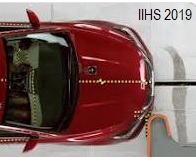Pickups' Passenger-Side Protection Not Up to the Job
April 22, 2019 | Category: Truck Accidents | ShareIn 2012, the Insurance Institute for Highway Safety (IIHS) began rating vehicles for driver-side protection, and in 2017, it launched the passenger-side test so that occupants on both sides of pickups are equally protected. IIHS reported in March 2019 that most pickups need better side protection for passengers. Most of the pickups that were recently tested in the IIHS passenger-side small overlap front test struggled to maintain their structure.
 The test, formerly known as the frontal offset test, replicates what happens when the front left corner of a vehicle collides with another vehicle or an object, such as a tree or utility pole.
The test, formerly known as the frontal offset test, replicates what happens when the front left corner of a vehicle collides with another vehicle or an object, such as a tree or utility pole.
IIHS says:
“Manufacturers have responded to the driver-side small overlap test by improving vehicle structures and airbags, and most vehicles now earn good ratings. However, IIHS research tests demonstrated that those improvements didn't always carry over to the passenger side. Discrepancies between the left and right sides of vehicles spurred us to develop a passenger-side small overlap test and begin issuing passenger-side ratings in 2017. The passenger-side test is the same as the driver-side test except the vehicle overlaps the barrier on the right side. In addition, instead of just one Hybrid III dummy, there are two, one in the driver’s seat and one in the passenger’s seat.”
IIHS rated four small and seven large pickups in the recent passenger-side test. In the large pickup category, only one large pickup earned a poor rating, and five other trucks earned a marginal rating.
What are the IIHS ratings criteria for the passenger-side pickup test?
Structural performance, injury measures and dummy movement are the three factors engineers consider.
- Structure/safety cage: After a crash, engineers measure the amount of intrusion into the occupant compartment at key locations in the interior and exterior of the vehicle. The number of intrusions and their pattern shows engineers how well the front-end crush zone managed and how well the safety cage performed.
- Injury measures: Dummies in the passenger-side small overlap tests have sensors which determine the likelihood that a passenger could sustain various types of injuries. These sensors are in the head, neck, chest, legs and feet.
- Restraints/dummy movement: Dummy movement is important. According to IIHS, a close call for a dummy can be an actual injury to a person. Technicians use greasepaint on a dummy’s head, knees, and lower legs prior to running the test. If the paint shows any contact with the vehicle after the test, engineers can evaluate a dummy’s movement.
The IIHS and the National Highway Traffic Safety Administration (NHTSA) both conduct vehicle testing. Before purchasing a new or used vehicle, prospective owners should click on the above links to be sure they are considering the safest vehicle.
“Should you or a loved one be injured in a vehicle accident, please contact our experienced legal team at Spivey Law Firm, Personal Injury Attorneys, P.A. We are available 24/7 for a free consultation,” said Fort Myers Truck Accident Attorney Randall Spivey.
Fort Myers Truck Accident Attorney, Randall L. Spivey is a Board Certified Trial Attorney – the highest recognition for competence bestowed by the Florida Bar and a distinction earned by just one (1%) percent of Florida attorneys. He has handled over 2,000 personal injury and wrongful death cases throughout Florida. For a free and confidential consultation to discuss your legal rights, contact the Spivey Law Firm, Personal Injury Attorneys, P.A., in Lee County at 239.337.7483 or toll free at 1.888.477.4839, or by email to Randall@SpiveyLaw.com. Visit SpiveyLaw.com for more information. You can contact Spivey Law Firm, Personal Injury Attorneys, P.A.in Charlotte County at 941.764.7748 and in Collier County 239.793.7748.

